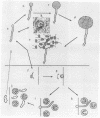Abstract
Pythium insidiosum, the etiologic agent of pythiosis insidiosii, causes life-threatening infections in humans and animals. Previous studies of the epidemiology of this disease hypothesized about the possible life cycle of this oomycete. Details, however, were not provided on the steps required to cause infection. We investigated the life cycle of P. insidiosum by inoculating pieces of equine skin and plant leaves and then studying the ensuing events with a scanning electron microscope. Our observations revealed that zoospores had a strong tropism for skin tissue, horse and human hair, and water lily and grass leaves and a weak attraction to a variety of other leaves. Encysted zoospores were observed on the favored leaves and skin. There they produced germ tubes and later abundant hyphal filaments that penetrated leaf tissues. Young sporangia had compact, thick walls. The sporangial wall was reduced to a fragile membrane when the sporangia had produced well-differentiated biflagellate zoospores. The encysted zoospores secreted an amorphous material that permitted the zoospores to adhere to skin and plant tissues. On the basis of these findings, a model to explain the life cycle of P. insidiosum is proposed.
Full text
PDF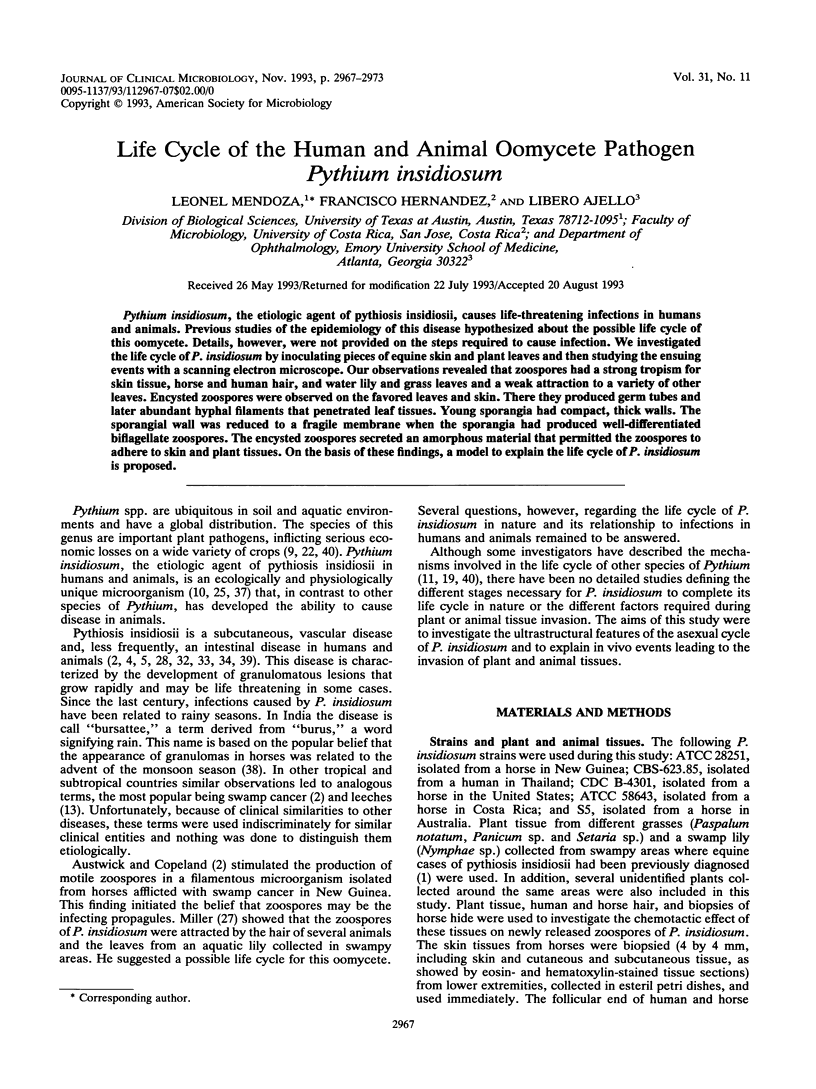
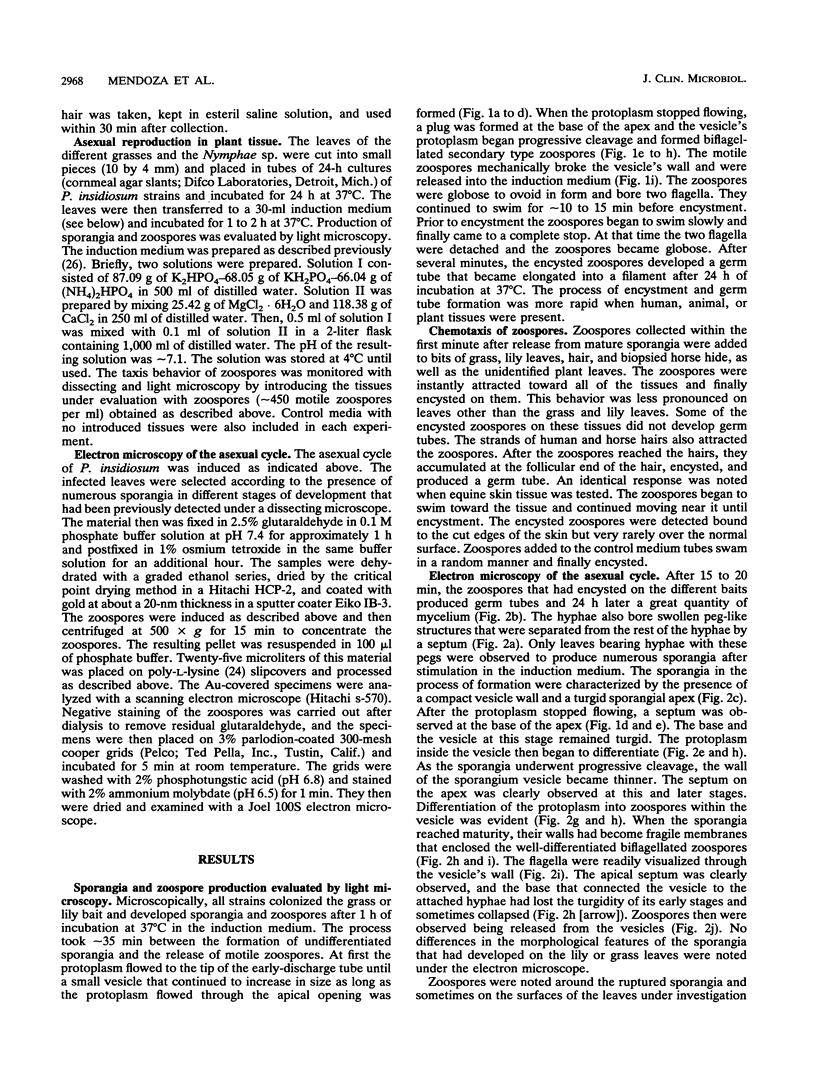
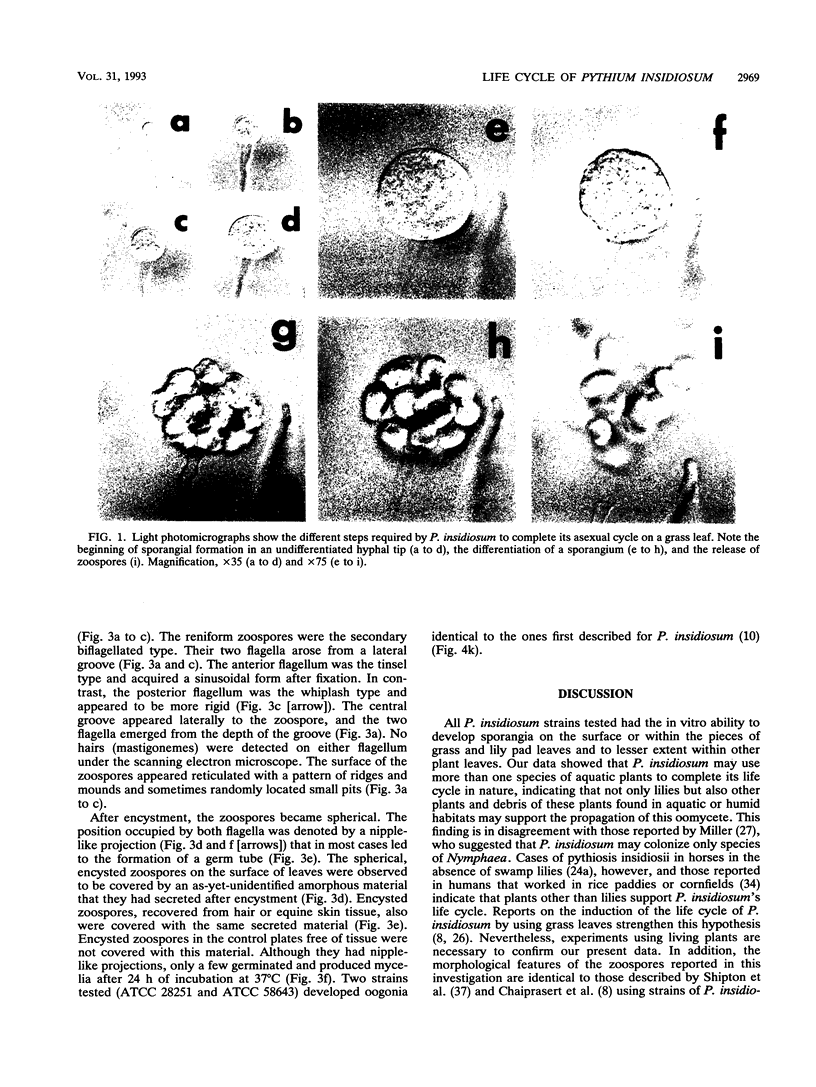
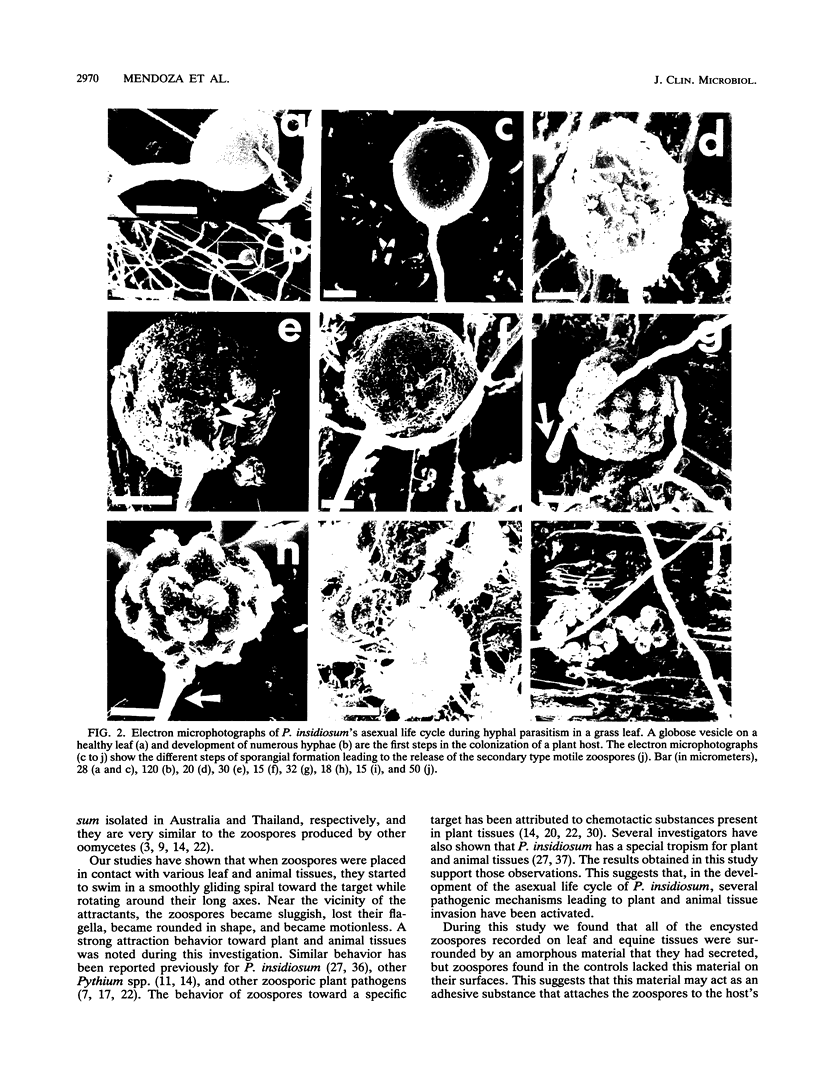

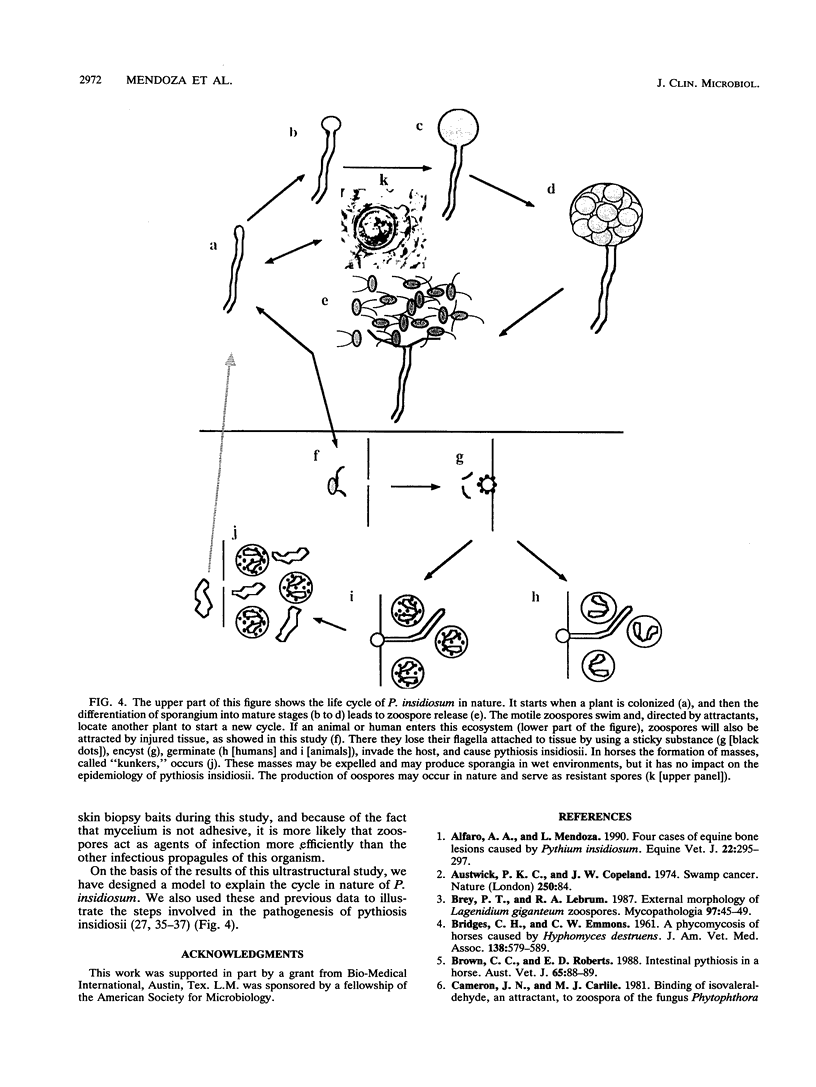
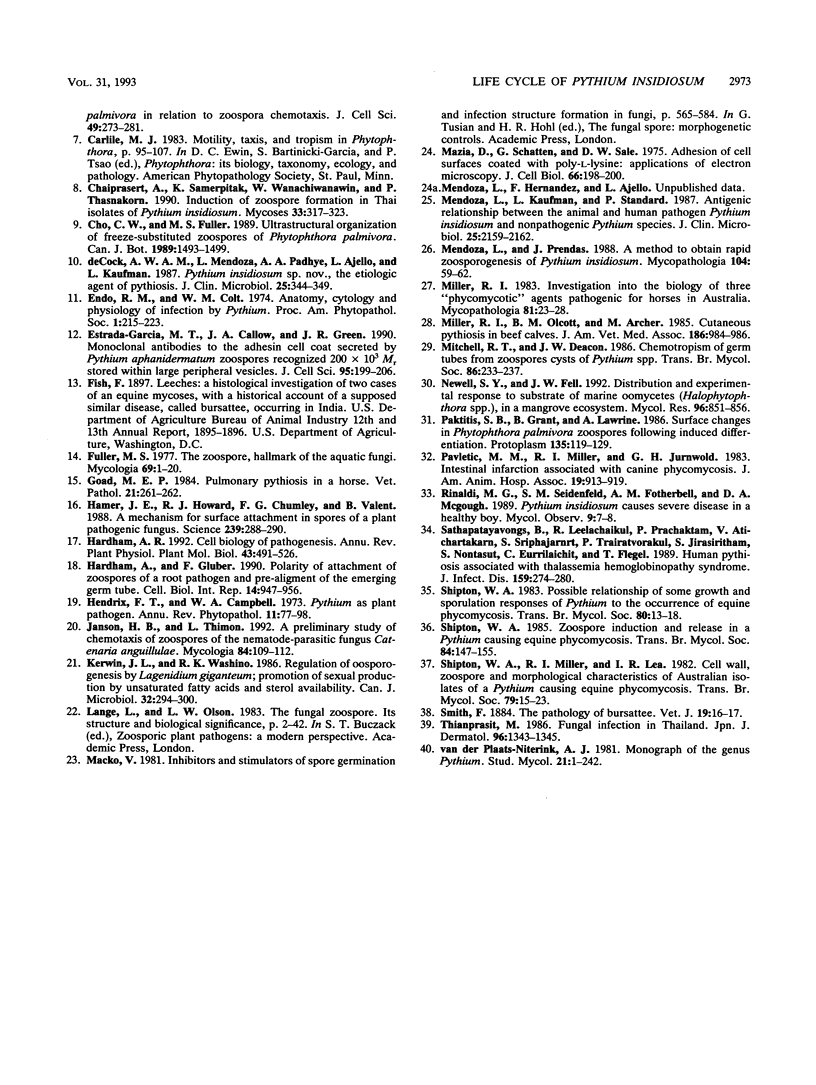
Images in this article
Selected References
These references are in PubMed. This may not be the complete list of references from this article.
- Alfaro A. A., Mendoza L. Four cases of equine bone lesions caused by Pythium insidiosum. Equine Vet J. 1990 Jul;22(4):295–297. doi: 10.1111/j.2042-3306.1990.tb04273.x. [DOI] [PubMed] [Google Scholar]
- Austwick P. K., Copland J. W. Swamp cancer. Nature. 1974 Jul 5;250(461):84–84. doi: 10.1038/250084a0. [DOI] [PubMed] [Google Scholar]
- Brown C. C., Roberts E. D. Intestinal pythiosis in a horse. Aust Vet J. 1988 Mar;65(3):88–89. doi: 10.1111/j.1751-0813.1988.tb07369.x. [DOI] [PubMed] [Google Scholar]
- Cameron J. N., Carlile M. J. Binding of isovaleraldehyde, an attractant, to zoospores of the fungus Phytophthora palmivora in relation to zoospore chemotaxis. J Cell Sci. 1981 Jun;49:273–281. doi: 10.1242/jcs.49.1.273. [DOI] [PubMed] [Google Scholar]
- Chaiprasert A., Samerpitak K., Wanachiwanawin W., Thasnakorn P. Induction of zoospore formation in Thai isolates of Pythium insidiosum. Mycoses. 1990 Jun;33(6):317–323. doi: 10.1111/myc.1990.33.6.317. [DOI] [PubMed] [Google Scholar]
- De Cock A. W., Mendoza L., Padhye A. A., Ajello L., Kaufman L. Pythium insidiosum sp. nov., the etiologic agent of pythiosis. J Clin Microbiol. 1987 Feb;25(2):344–349. doi: 10.1128/jcm.25.2.344-349.1987. [DOI] [PMC free article] [PubMed] [Google Scholar]
- Goad M. E. Pulmonary pythiosis in a horse. Vet Pathol. 1984 Mar;21(2):261–262. doi: 10.1177/030098588402100224. [DOI] [PubMed] [Google Scholar]
- Hamer J. E., Howard R. J., Chumley F. G., Valent B. A mechanism for surface attachment in spores of a plant pathogenic fungus. Science. 1988 Jan 15;239(4837):288–290. doi: 10.1126/science.239.4837.288. [DOI] [PubMed] [Google Scholar]
- Mazia D., Schatten G., Sale W. Adhesion of cells to surfaces coated with polylysine. Applications to electron microscopy. J Cell Biol. 1975 Jul;66(1):198–200. doi: 10.1083/jcb.66.1.198. [DOI] [PMC free article] [PubMed] [Google Scholar]
- Mendoza L., Kaufman L., Standard P. Antigenic relationship between the animal and human pathogen Pythium insidiosum and nonpathogenic Pythium species. J Clin Microbiol. 1987 Nov;25(11):2159–2162. doi: 10.1128/jcm.25.11.2159-2162.1987. [DOI] [PMC free article] [PubMed] [Google Scholar]
- Mendoza L., Prendas J. A method to obtain rapid zoosporogenesis of Pythium insidiosum. Mycopathologia. 1988 Oct;104(1):59–62. doi: 10.1007/BF00437925. [DOI] [PubMed] [Google Scholar]
- Miller R. I. Investigations into the biology of three 'phycomycotic' agents pathogenic for horses in Australia. Mycopathologia. 1983 Jan 17;81(1):23–28. doi: 10.1007/BF00443905. [DOI] [PubMed] [Google Scholar]
- Miller R. I., Olcott B. M., Archer M. Cutaneous pythiosis in beef calves. J Am Vet Med Assoc. 1985 May 1;186(9):984–986. [PubMed] [Google Scholar]
- Sathapatayavongs B., Leelachaikul P., Prachaktam R., Atichartakarn V., Sriphojanart S., Trairatvorakul P., Jirasiritham S., Nontasut S., Eurvilaichit C., Flegel T. Human pythiosis associated with thalassemia hemoglobinopathy syndrome. J Infect Dis. 1989 Feb;159(2):274–280. doi: 10.1093/infdis/159.2.274. [DOI] [PubMed] [Google Scholar]
- Smith J. L., Lane A. C., Hodges E., Reynolds W. M., Howell W. M., Jones D. B., Janson C. H. T-cell receptor variable (V) gene usage by lymphoid populations in T-cell lymphoma. J Pathol. 1992 Feb;166(2):109–112. doi: 10.1002/path.1711660205. [DOI] [PubMed] [Google Scholar]






